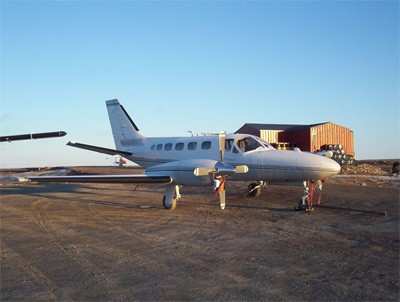Early Evidence Inconclusive, Right Prop Shows No Sign Of Power
At Impact
The NTSB has released its preliminary report in an accident
involving a Cessna 441 airplane which went down on approach to York
Airport in Pennsylvania on December 22nd last year. The flight
appeared to be fairly normal up until the pilot overshot the
centerline of the runway and began a right turn before impacting
terrain. The pilot, who was the only person on board at the time of
the accident, was fatally injured.

NTSB Identification: ERA12FA120
14 CFR Part 91: General Aviation
Accident occurred Thursday, December 22, 2011 in Nashville,
PA
Aircraft: CESSNA 441, registration: N48BS
Injuries: 1 Fatal.
This is preliminary information, subject to change, and may
contain errors. Any errors in this report will be corrected when
the final report has been completed.
On December 22, 2011, about 1735 eastern standard time, a Cessna
441, N48BS, was substantially damaged when it impacted terrain near
Nashville, Pennsylvania, while approaching York Airport (THV),
Thomasville, Pennsylvania. The certificated commercial pilot was
fatally injured. Night visual meteorological conditions prevailed.
The airplane had been operating on an instrument flight rules (IFR)
flight plan from Long Beach Airport - Daugherty Field (LGB), Long
Beach, California, to THV; however, the pilot had cancelled the
flight plan and was proceeding visually via the airport traffic
pattern at the time of the accident. The personal flight was
operating under the provisions of 14 Code of Federal Regulations
Part 91.
Preliminary air traffic control information indicated that the
airplane departed LGB about 1105 (0805 Pacific standard time) and
climbed to 33,000 feet. About 1522, it climbed to 35,000 feet, and
about 1639, it began a descent. At 1707, the pilot cancelled the
IFR flight plan with New York Center, and at 1716, terminated
flight following with Harrisburg Approach Control.
Preliminary radar information indicated that at 1719, the
airplane was about 24 miles west of THV at 1,700 feet. The airplane
continued eastbound, entering a 45-degree left downwind for runway
35. The airplane subsequently turned onto a left base, then
slightly overshot runway centerline before starting a right turn
and disappearing from radar.
The wreckage was located on open, rolling terrain, about 145
degrees magnetic, 1.56 statute miles from THV runway 35, in the
vicinity of 39 degrees, 53.53 minutes north latitude, 076 degrees,
51.11 minutes west longitude. There was no wreckage path, and
ground indentations matching the positions of extended landing
gear, and the nose and tail of the airplane indicated that it had
initially impacted the ground almost vertically, heading about 060
degrees magnetic. It appeared to have then bounced once, coming
rest on a heading of about 090 degrees magnetic.
The airplane's tail section was broken off to the left, and the
left wing outboard of the left engine was broken forward. The aft
portion of the right wing root was pushed into the fuselage, and
the landing gear were fractured upwards. The overall damage noted
was consistent with the airplane having been in a right-turning
flat spin when it initially impacted the ground.
Cessna 441 File Photo

Flight control continuity was confirmed from all flight control
surfaces to the front of the damaged cabin area, where there was
cable impingement. The flap handle was in approach, and the flap
actuator position equated with the flaps being extended
approximately 35 degrees.
The left engine throttle was near flight idle, and the right
engine throttle was full forward; however, the effects of ground
impact on their positions could not be determined. Both condition
levers were in the EMERG SHUT-OFF position, but according to a
witness, they were pulled to that position after initial responders
smelled fuel.
About 4 gallons of fuel were drained from the right fuel tank;
however, the tank and the fuel hopper were breached. There was also
an odor of fuel in the soil beneath the wing. Fuel quantity from
the left fuel tank could not be determined due to the extent of
damage to the tank and to the wing. When the wing was lifted, fuel
flowed from a breach near the wingtip.
The right propeller did not exhibit any signs of power at
impact. Two of the four propeller blades exhibited no damage while
the other two had some bending, but no significant chordwise
scratching. The right propeller did not appear to have been in
feather at impact.
The left propeller exhibited significant damage. Two of the four
propeller blades were broken off at the hub, while the third blade
was dangling loose in the hub and the fourth blade was bent in a
direction opposite normal rotation.
Both engines, both propellers, and both advisory light panels
were retained for further examination by the Safety Board.
 ANN's Daily Aero-Linx (04.16.24)
ANN's Daily Aero-Linx (04.16.24) Aero-News: Quote of the Day (04.16.24)
Aero-News: Quote of the Day (04.16.24) Airborne 04.10.24: SnF24!, A50 Heritage Reveal, HeliCycle!, Montaer MC-01
Airborne 04.10.24: SnF24!, A50 Heritage Reveal, HeliCycle!, Montaer MC-01 Airborne 04.12.24: SnF24!, G100UL Is Here, Holy Micro, Plane Tags
Airborne 04.12.24: SnF24!, G100UL Is Here, Holy Micro, Plane Tags Airborne-Flight Training 04.17.24: Feds Need Controllers, Spirit Delay, Redbird
Airborne-Flight Training 04.17.24: Feds Need Controllers, Spirit Delay, Redbird




